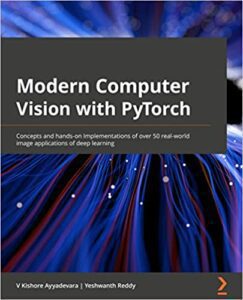Yeshwanth Reddy is the author of Modern Computer Vision with PyTorch, we got the chance to sit down with him and find out more about his experience of writing with Packt.
Q: How did you become an author for Packt? Tell us about your journey.
Yeshwanth: Kishore and I are work colleagues and have worked together for over two years on computer vision related problems. Seeing the potential breadth and depth of the content and the amount of ease in implementing deep learning using PyTorch over Tensorflow, we realized the need to formalize our work and thoughts into a book. As he already has had a journey with Packt in the past, he immediately reached out to Packt and proposed a rough outline of all the deep learning tasks we would want to cover in the book. Within two days we were given a green signal and the journey to become an author was ON!
Q: What was your motivation for writing this book?
Yeshwanth: Learning is a never ending collection of ‘aha’ moments. We wanted to share our moments of learning with the readers with as much ease as clarity as possible.
Q: How long did it take you to write the book?
Yeshwanth: One year.
Q: What kind of research did you do, and how long did you spend researching before beginning the book?
Yeshwanth: Both Kishore and I have extensively worked on research oriented problems at work, even before we met as colleagues. So our entire careers were spread with challenges and experiments in solving tasks through deep learning and both of us had good experience with reading latest papers or surveying the landscapes. We have done the same for each and every section in the book. First we would gather all the deep learning implementations and brainstorm which ideas were easiest to implement as well as explain. Sometimes we would combine multiple ideas into one.
Q: What’s your take on the technologies discussed in the book? Where do you see these technologies heading in the future?
Yeshwanth: Neural Networks have played a vital role in the past decade and will continue to dominate the AI space. The intricate implementation details of each task might change in the future, but the core fundamentals will remain and we ensured to impart knowledge that is not rigid, but malleable and usable in the reader’s own contexts however advanced the requirement maybe.
Q: Did you face any challenges during the writing process? How did you overcome them?
Yeshwanth: It was a memorable experience and there were very few challenges in writing the content was quite gratifying.
Q: How do you see these technologies benefiting society in the long run?
Yeshwanth: Imparting ground breaking techniques to the masses will help even out the field for AI and will keep the society informed of their strengths and limitations. I sincerely believe such knowledge will help an individual to accomplish whatever is needed without risking their energies and time into outsourcing tasks that can be trivially accomplished in AI space.
Q: What advice would you give to readers learning tech? Do you have any top tips?
Yeshwanth: Understand the fundamentals first. You can run only after you learn to walk.
Q. How do you keep up-to-date on your tech?
Yeshwanth: Mostly Twitter, YouTube and Reddit
Q. Do you have a blog that readers can follow?
Yeshwanth: I have a small personal blog – sizhky.github.io
Q. Can you share any blogs, websites and forums to help readers gain a holistic view of the tech they are learning?
Yeshwanth: I strongly suggest beginners to start with CS231 lectures and assignments (an offering from Stanford) as their starting point for deep-learning. Solving the assignments is extremely hands on and gratifying. The content is well organized for any python beginner to pick up. kaggle.com is the best source for experimenting.
Q. How would you describe you author journey with Packt? Would you recommend Packt to aspiring authors?
Yeshwanth: Working with everyone was a delight and I would recommend Packt to aspiring authors.
You can find Yeshwanth’s books on Amazon by clicking on the cover image:









